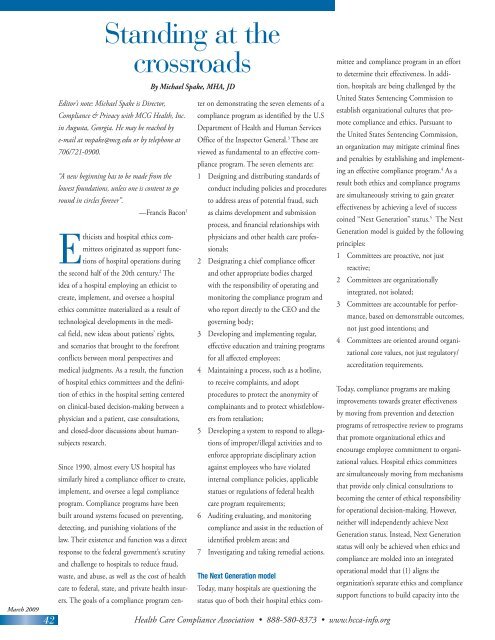BP - Health Care Compliance Association
BP - Health Care Compliance Association
BP - Health Care Compliance Association
Create successful ePaper yourself
Turn your PDF publications into a flip-book with our unique Google optimized e-Paper software.
March 2009<br />
42<br />
Standing at the<br />
crossroads<br />
Editor’s note: Michael Spake is Director,<br />
<strong>Compliance</strong> & Privacy with MCG <strong>Health</strong>, Inc.<br />
in Augusta, Georgia. He may be reached by<br />
e-mail at mspake@mcg.edu or by telephone at<br />
706/721-0900.<br />
“A new beginning has to be made from the<br />
lowest foundations, unless one is content to go<br />
round in circles forever”.<br />
—Francis Bacon 1<br />
Ethicists and hospital ethics committees<br />
originated as support functions<br />
of hospital operations during<br />
the second half of the 20th century. 2 The<br />
idea of a hospital employing an ethicist to<br />
create, implement, and oversee a hospital<br />
ethics committee materialized as a result of<br />
technological developments in the medical<br />
field, new ideas about patients’ rights,<br />
and scenarios that brought to the forefront<br />
conflicts between moral perspectives and<br />
medical judgments. As a result, the function<br />
of hospital ethics committees and the definition<br />
of ethics in the hospital setting centered<br />
on clinical-based decision-making between a<br />
physician and a patient, case consultations,<br />
and closed-door discussions about humansubjects<br />
research.<br />
By Michael Spake, MHA, JD<br />
Since 1990, almost every US hospital has<br />
similarly hired a compliance officer to create,<br />
implement, and oversee a legal compliance<br />
program. <strong>Compliance</strong> programs have been<br />
built around systems focused on preventing,<br />
detecting, and punishing violations of the<br />
law. Their existence and function was a direct<br />
response to the federal government’s scrutiny<br />
and challenge to hospitals to reduce fraud,<br />
waste, and abuse, as well as the cost of health<br />
care to federal, state, and private health insurers.<br />
The goals of a compliance program center<br />
on demonstrating the seven elements of a<br />
compliance program as identified by the U.S<br />
Department of <strong>Health</strong> and Human Services<br />
Office of the Inspector General. 3 These are<br />
viewed as fundamental to an effective compliance<br />
program. The seven elements are:<br />
1 Designing and distributing standards of<br />
conduct including policies and procedures<br />
to address areas of potential fraud, such<br />
as claims development and submission<br />
process, and financial relationships with<br />
physicians and other health care professionals;<br />
2 Designating a chief compliance officer<br />
and other appropriate bodies charged<br />
with the responsibility of operating and<br />
monitoring the compliance program and<br />
who report directly to the CEO and the<br />
governing body;<br />
3 Developing and implementing regular,<br />
effective education and training programs<br />
for all affected employees;<br />
4 Maintaining a process, such as a hotline,<br />
to receive complaints, and adopt<br />
procedures to protect the anonymity of<br />
complainants and to protect whistleblowers<br />
from retaliation;<br />
5 Developing a system to respond to allegations<br />
of improper/illegal activities and to<br />
enforce appropriate disciplinary action<br />
against employees who have violated<br />
internal compliance policies, applicable<br />
statues or regulations of federal health<br />
care program requirements;<br />
6 Auditing evaluating, and monitoring<br />
compliance and assist in the reduction of<br />
identified problem areas; and<br />
7 Investigating and taking remedial actions.<br />
<strong>Health</strong> <strong>Care</strong> <strong>Compliance</strong> <strong>Association</strong> • 888-580-8373 • www.hcca-info.org<br />
The Next Generation model<br />
Today, many hospitals are questioning the<br />
status quo of both their hospital ethics committee<br />
and compliance program in an effort<br />
to determine their effectiveness. In addition,<br />
hospitals are being challenged by the<br />
United States Sentencing Commission to<br />
establish organizational cultures that promote<br />
compliance and ethics. Pursuant to<br />
the United States Sentencing Commission,<br />
an organization may mitigate criminal fines<br />
and penalties by establishing and implementing<br />
an effective compliance program. 4 As a<br />
result both ethics and compliance programs<br />
are simultaneously striving to gain greater<br />
effectiveness by achieving a level of success<br />
coined “Next Generation” status. 5 The Next<br />
Generation model is guided by the following<br />
principles:<br />
1 Committees are proactive, not just<br />
reactive;<br />
2 Committees are organizationally<br />
integrated, not isolated;<br />
3 Committees are accountable for performance,<br />
based on demonstrable outcomes,<br />
not just good intentions; and<br />
4 Committees are oriented around organizational<br />
core values, not just regulatory/<br />
accreditation requirements.<br />
Today, compliance programs are making<br />
improvements towards greater effectiveness<br />
by moving from prevention and detection<br />
programs of retrospective review to programs<br />
that promote organizational ethics and<br />
encourage employee commitment to organizational<br />
values. Hospital ethics committees<br />
are simultaneously moving from mechanisms<br />
that provide only clinical consultations to<br />
becoming the center of ethical responsibility<br />
for operational decision-making. However,<br />
neither will independently achieve Next<br />
Generation status. Instead, Next Generation<br />
status will only be achieved when ethics and<br />
compliance are molded into an integrated<br />
operational model that (1) aligns the<br />
organization’s separate ethics and compliance<br />
support functions to build capacity into the

















